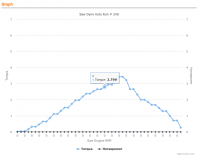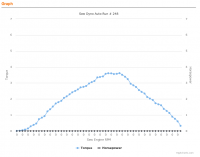MustangMike
Mastermind Approved!
- Local time
- 9:06 PM
- User ID
- 338
- Joined
- Dec 30, 2015
- Messages
- 11,539
- Reaction score
- 36,412
- Location
- Brewster, NY
Eric, the graphs look awesome, thanks. For better or worse, I eliminated that 8+ Hp # for 044 from my calculation as an outlier, or my computed Hp for that run would have been 7.73 instead of 7.56.
My thought with taking 7 consecutive data points (or more) was to reduce the effect of inertia on the calculations. It was the fairest method I could come up with. However, it also forces you to use #s that may not be in the peak Hp range. For example, on this run, the first # I used is from 7,500 RPM.
Perhaps that saw really does briefly hit 8 hp at 11,000 RPMs. If you look at the data points right before and after 8.746 Hp they are 7.893 and 7.872.
Don't know if it is feasible, but if we had some type of hydraulic resistance before the saw was accelerated, it would take inertia out of the picture.
I'll continue this stuff later, got to get back to planting my garden while the weather is good!
My thought with taking 7 consecutive data points (or more) was to reduce the effect of inertia on the calculations. It was the fairest method I could come up with. However, it also forces you to use #s that may not be in the peak Hp range. For example, on this run, the first # I used is from 7,500 RPM.
Perhaps that saw really does briefly hit 8 hp at 11,000 RPMs. If you look at the data points right before and after 8.746 Hp they are 7.893 and 7.872.
Don't know if it is feasible, but if we had some type of hydraulic resistance before the saw was accelerated, it would take inertia out of the picture.
I'll continue this stuff later, got to get back to planting my garden while the weather is good!









